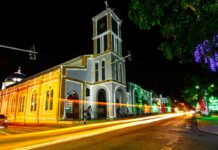The Republic of Colombia according to 1991 constitution It is divided administratively and politically into 33 divisions; 32 Departments and one capital city (Bogotá); Each department is managed by a Governor, which is democratically elected by popular vote and by a departmental assembly which is responsible for political control of the governor and issuing administrative acts called “ordinances”, which is also democratically elected by popular vote, its members are called “Deputies“, the term of office of the governors and deputies of the departmental assembly is 4 years.
The departments are subdivided into municipalities, whose administration is in charge of a mayor and a city Council elected by popular vote for a period equal to that of the departmental dignitaries (4 years). Some departments are also subdivided into non-municipalized areas (formerly called departmental townships).
List of the Departments of Colombia and their capitals:
| Department | Capital | Number of Municipalities |
| Amazon | Leticia | 2 |
| Antioch | Medellin | 125 |
| Arauca | Arauca | 7 |
| Atlantic | Barranquilla | 23 |
| Bolivar | Cartagena de Indias | 45 |
| Boyacá | Tunja | 123 |
| Caldas | Manizales | 27 |
| Caqueta | Florencia | 16 |
| Casanare | Yopal | 19 |
| Cauca | Popayan | 41 |
| Cease | Valledupar | 25 |
| crashed | Quibdo | 31 |
| Cordova | Montería | 30 |
| Cundinamarca | Bogota | 116 |
| Guainía | Inirida | 2 |
| Guaviare | San José del Guaviare | 4 |
| Huila | Neiva | 37 |
| La Guajira | Riohacha | 15 |
| Cupcake | Santa Marta | 30 |
| Goal | Villavicencio | 29 |
| Nariño | Pasto | 64 |
| North of Santander | San José de Cúcuta | 40 |
| Putumayo | Mocoa | 13 |
| Quindío | Armenia | 12 |
| Risaralda | Pereira | 14 |
| San Andrés and Providencia | San Andrés | 2 |
| Santander | Bucaramanga | 87 |
| Sucre | Sincelejo | 26 |
| Tolima | Ibagué | 47 |
| Cauca's Valley | Cali | 42 |
| Vaupes | Mitú | 3 |
| Vichada | Puerto Carreño | 4 |
History of the Departments of Colombia
The Colombian departments have their origin in the political-administrative division of New Granada (current Colombia and Panama), which was organized into provinces that had a territorial division more or less similar to the current departments. With the constitution of 1858, the nation adopted the federal republic system, calling itself United States of Colombia, replacing the provinces with nine sovereign states (Antioquia, Bolívar, Boyacá, Cauca, Cundinamarca, Magdalena, Panama, Santander and Tolima). The centralist constitution of 1886 He changed the name to the Republic of Colombia and transformed the states into departments.
The reforms of 1905 and 1910 allowed the creation of new territories and entities from the division of part of the territories of the departments of that time, with them new departments, mayors and commissioners were created. The 1991 constitution elevated the existing mayoralties and police stations to the category of departments, thus creating the current administrative-political division of Colombia.







